Reactive Solutions - An FHWA Technical Update on Alkali-Silica Reactivity
Summer 2009 - Volume 2, Issue 3
Inside this Issue:
- Case Study: Delaware ASR-Affected Pavement Receives Overlay
- Editor's Corner
- Proposed Concrete Overlay on ASR-Affected Pavement in Michigan
- US Army Corps of Engineers Releases New ASR Specification
- Ask The Experts
- This issue's Ask.Send.Receive.
- ASR-Affected Pavement in Delaware to be Treated with Lithium Nitrate This Summer
- Schedule of Events
- Announcement
Case Study: Delaware ASR-Affected Pavement Receives Overlay
In the early 1990's, a segment of State Route 1 in Delaware, between US 13 and State Route (SR) 273, was constructed with materials that did not prevent alkali-silica reactivity (ASR). This particular section is a major north-south corridor in Delaware, and by the mid-1990's, the pavement began showing early signs of ASR. At the time, the Delaware Department of Transportation (DelDOT) did not have the funds for a major rehabilitation of this corridor. A decision was made, based upon the favorable results that came out of the Strategic Highway Research Program (SHRP) showing that if enough lithium could penetrate the concrete, the ASR mechanism would slow down. Based upon this research, DelDOT decided to try a topical application of lithium. This work was conducted over four years (two applications per year) to try and slow the deterioration while funds could be appropriated for more in depth rehabilitation.
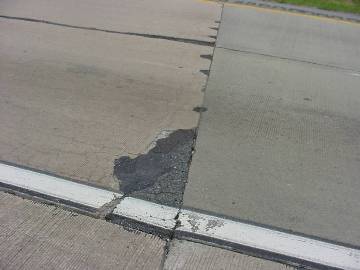
The left side of the image shows the section of SR-1 that had no ASR mitigation and was overlaid with NovaChip and a 2-inch hot mix asphalt layer. The right side of the pavement was constructed with slag cement as an ASR preventative effort.
In the late 1990's, when a portion of the control section (where no lithium was applied) became deteriorated, DelDOT decided to construct a partial depth hot-mix asphalt inlay of the ASR-affected concrete. The plans for this project consisted of removing 2" of the ASR concrete, application of lithium, and then a 2" thick hot-mix asphalt surface layer. Unfortunately, within six months, the asphalt overlay began showing signs of deterioration. In hindsight, DelDOT believes that moisture was "locked" in at the interface between the concrete and the overlay, which may have actually accelerated the ASR deterioration.
The treated pavement continued to show signs of deterioration, so in 2006 DelDOT designed and constructed a project to place a different type of overlay. DelDOT proposed a 1.5" thick ultra-thin surface layer of a proprietary product known as NovachipTM, under a 2" hot-mix asphalt overlay. The NovachipTM layer was anticipated to perform as a waterproofing membrane. To date, that overlay technique is still performing very well and there are other ASR affected concrete pavements in the state that are being reviewed for the same rehabilitation strategy. For more information, please contact Jim Pappas at James.Pappas@state.de.us.
Editor's Corner
Dear Readers,
This issue is all about concrete pavements. The Delaware DOT article reports mixed experiences with using asphalt overlays on ASR-affected pavements, whereas a concrete overlay is proposed for an ASR-damaged pavement in Michigan. With appropriate documentation and monitoring, such cases will provide invaluable information on the performance of different overlay systems for extending the life of concrete pavements affected by ASR. This June also marks the execution of the first project under the FHWA's ASR Demonstration and Deployment Program as 16 lane miles of US Route 113 in Delaware receive a topical treatment with lithium nitrate. The success of such a treatment depends on the ability of the lithium to penetrate significantly into the concrete (look for an update on this project in future issues). Finally we report on a new test method for evaluating the efficacy of lithium admixtures for preventing ASR in new concrete construction. This protocol, developed by the US Corps of Engineers, makes use of a modified version of the accelerated mortar bar test.
Sincerely,
Mike Thomas
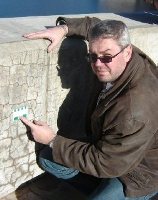
Dr. Michael Thomas, University of New Brunswick.
Proposed Concrete Overlay on ASR-Affected Pavement in Michigan
In Auburn Hills, Michigan, a section of pavement along Squirrel Road (north of Hamlin Road, near Oakland Community College) is under consideration for a concrete overlay treatment. A petrographic report conducted in 2002 confirmed that the cracking distress from a core extracted from this location was shown to be caused by ASR. Although ASR activity was prevalent along the full depth of the core, the majority of the cracking at the time of the examination was located in the top 4.5 inches of the core. The damage was shown to be "relatively mild", and at the time of the report, the pavement was over ten years old. Although the report noted that the pavement could still provide many years of serviceable life, early freezing distress was also noted at the top 3 millimeters of the core.
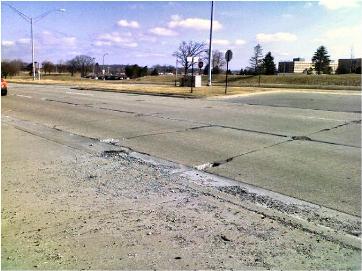
Squirrel Road in Auburn Hills, Michigan (photo taken March 2009).
Extensive damage is noted along the longitudinal and transverse joints in the existing pavement, which has prompted engineers to propose a concrete overlay. Discussions were held this spring to determine the course of action for this road.
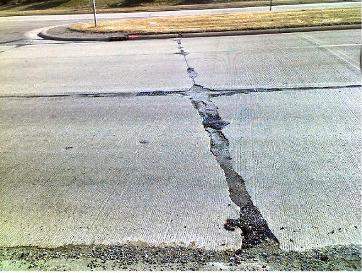
Extensive joint damage shown on Squirrel Road (photo taken March 2009).
For more information about the status of Squirrel Road, please contact Dan DeGraaf with the Michigan Concrete Pavement Association at ddegraaf@miconcpave.com.
US Army Corps of Engineers Releases New ASR Specification
New specification focuses on using lithium nitrate
The US Army Corps of Engineers has released a new alkali-silica reaction (ASR) specification (Test Method CRD-C 662-09), titled Test Method for Determining the Alkali Silica Reactivity of Combinations of Cementitious Materials, Lithium Nitrate Admixture, and Aggregate (Accelerated Mortar-Bar Method). The test method was developed by modifying the American Society for Testing and Materials (ASTM) specification C1567. The Army Corps specification includes procedures to evaluate the effectiveness of lithium nitrate's ability to mitigate the expansion of a single aggregate. The test can be conducted either using the admixture alone or in combination with supplemental cementitious materials (SCM). The specification also provides guidance on determining the minimum dose required for mitigation.
The new specification can be accessed at the Army Corps' website (http://www.wes.army.mil/SL/MTC/handbook/handbook.htm) and scrolling to CRD-C 662, or at FHWA's ASR Reference Center (https://www.fhwa.dot.gov/pavement/concrete/asr/reference.cfm). For more information, comments, or recommendations for revisions, please contact Mr. Toy S. Poole by email at Toy.S.Poole@usace.army.mil.
Ask The Experts
"I have an interest in critical building structures in Alaska. What is known about the aggregate in Alaska? I have petrographic and mortar bar tests that show a high likelihood of reactive aggregate. The FAA and USACE require mitigation for paving, but the tradition has been to allow reactive aggregate for building structures. Do you know of anyone who has studied reactive aggregate in Alaska or reactive aggregate in critical building structures?"
Submitted by Harold O. Sprague, P.E. Black & Veatch Special Projects Corp.
As of now, significant cases of ASR in Alaska are not well known, likely due to the cold weather conditions and the relatively young age of the concrete infrastructure in Alaska. However, this does not mean that there are no reactive aggregates in Alaska. There is a strong potential that alkali-silica reactive aggregates exist there because of the similarities in the geology of that territory and that of British Columbia, where several aggregates have been tested and found to be reactive.
Got a question? Finding it difficult to get a clear-cut answer?
This section of the newsletter is dedicated to answering your ASR-related questions. In each issue, our editorial committee selects and answers one question submitted by you, the reader. Ask one of our experts-we're here to listen.
Email your question to asrnewsletter@transtec.us.
A.S.R. - Ask.Send.Receive.
This Issue's Question
Does your state currently inventory existing structures for ASR?
Submit your answers to asrnewsletter@transtec.us.

ASR-Affected Pavement in Delaware to be Treated with Lithium Nitrate This Summer
Treatment kicks off first field trial for the FHWA ASR Development and Deployment Program
The first ASR field trial application under the Federal Highway Administration's (FHWA) Alkali-Silica Reactivity (ASR) Development and Deployment Program has been set for this summer.
A section of US 113 in Delaware between Ellendale and Georgetown, which was constructed of jointed plain concrete pavement in the mid-1990's, will be the first field trial project. At the time, Delaware's mitigation for ASR consisted of several contractor options: using non-reactive aggregates, using slag cement, use of pozzolans, or the use of low alkali cement. At the time, low alkali cement was defined in the Delaware DOT (DelDOT) specifications as a cement having an alkali content less than 0.60%.
At the time of construction for this particular concrete roadway, the contractor chose to use low alkali cement for his ASR mitigation. The roadway construction went well; however, the in service roadway is now starting to show signs of early age ASR which has been verified through petrographic examination. Since this roadway has not reached the end of its serviceable life and it appears the ASR is also in its early stages, DelDOT has decided to try a topical application of lithium to mitigate the ASR and extend the service life of the pavement.
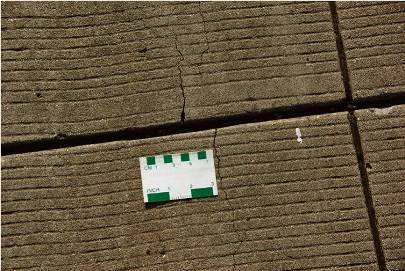
Cracking seen on US 113 near Georgetown, Delaware.
The field application in Delaware is scheduled for late June so look for upcoming information and pictures of the field application in future editions of this newsletter. For more information, contact Gina Ahlstrom with FHWA at Gina.Ahlstrom@dot.gov.
Schedule of Events
August
16-18 34th Conference on Our World in Concrete & Structures, Singapore
24-26 4th International Conference on Construction Materials, Nagoya, Japan
September
12-15 PCI Annual Convention / National Bridge Conference, San Antonio, TX
17-19 ASCC 2009 Annual Conference, Atlanta, GA
October
13-17 CANMET / ACI International Conference, Seville, Spain
Announcement
The FHWA ASR Development and Deployment Team is searching for proposed concrete overlay projects. If your state is planning a concrete overlay on an ASR-affected pavement and are interested in participating in an ASR field trial, please contact Gina Ahlstrom at Gina.Ahlstrom@dot.gov. or (202) 366-4612.
Technical Editor: Dr. Michael Thomas
Managing Editor: Bebe Resendez
FHWA Contact: Gina Ahlstrom, Concrete Pavement Engineer (Gina.Ahlstrom@dot.gov.) FHWA-Office of Pavement Technology
Editorial Committee: Lizanne Davis (FMC Corporation), Steve Lane (Virginia DOT), Colin Lobo (National Ready Mix Concrete Association), Brian Merrill (Texas DOT), Jim Pappas (Delaware DOT), Peter Taylor (CP Tech Center), Paul Tennis (Portland Cement Association), Leif Wathne (American Concrete Pavement Association)
Get On the Reactive Solutions Mailing List
Want to subscribe to future issues? Email us at asrnewsletter@transtec.us. - Subscriptions are free.

